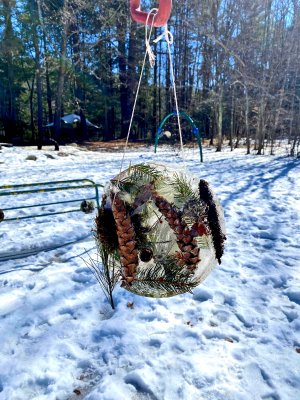Easy Ways to Bring Your Students Outside
The classroom isn’t the only place students can learn—use these activities to bring them outside for a while, which can relieve stress.
Your content has been saved!
Go to My Saved Content.Are you concerned about the well-being of your students? Taking them outdoors may be just what you need to relieve the stress that many of us feel as we continue adjusting to another unusual school year. More and more research shows what schools are already seeing: Time spent learning outdoors can improve children’s mental and physical health, which is something today’s students need more than ever.
One of the most valuable things I’ve learned from teaching during the pandemic is that my students are happier the more time we spend in nature. Being outdoors relieves stress and anxiety, gives kids the freedom to move, and helps them focus. All of this leads to a more joyful, balanced, productive school day. Inside-Outside is an excellent place to begin when thinking about how you can include the outdoors more in your instruction.
Knowing the benefits of outdoor learning, I challenged myself this school year to have “Wednesday in the Woods,” a day when most of the instruction for my first-grade students takes place outdoors. The children look forward to it every week. It’s time for them to actively explore the environment around our schoolyard and take their learning outside to a more open, calming setting. When safely distanced, we can take off our masks, breathe in the fresh air, and relax.
The challenge has been figuring out what to do with my students each week once we get outside. I’ve had to find creative ways to structure outdoor lessons that are connected to our curriculum. In searching for simple activities that I could repeatedly use outdoors, ones that would not need a lot of preparation, I’ve found the following ones to be the most engaging for my students. The best thing is that they are easily adaptable to a variety of topics and age levels, and they can be used in many different environmental settings, even if you do not have easy access, as I do to the woods.
5 Outdoor Learning Activities
1. Read-aloud: One of the easiest ways to start bringing your students outdoors is for read-aloud. Bring your storybook out to the nearest tree or grassy area near your classroom. Have your students circle up or spread out on outdoor seating options such as foam cushions, individual blankets, or paint buckets turned upside down.
Listening to a story while gathered outside together makes it feel like more of an adventure, especially if you choose inspiring stories that are set in nature, such as Fatima’s Great Outdoors, or stories that teach about nature, such as What’s Inside a Flower? Outdoor story time can break up a long school day and rejuvenate kids’ spirits as they take in deep breaths of fresh air.
2. Journal writing: I frequently take my students outside with clipboards and markers for Writers’ Workshop. Many times we journal about what we notice outside. We especially do this as the seasons change. Children will choose a special tree to observe as it changes throughout the year. They will look for changes to the tree or signs of animals visiting it.
Using prompts such as “I see _____, I think_____, I wonder _____,” children observe, think about, and reflect on what is happening in the outdoor world around them. They use the outdoors to imagine they are scientists, observing and documenting what they see. These journaling activities sometimes lead to other writing activities, such as nonfiction “all about trees” books or poetry writing.
3. Scavenger hunts: Put a scavenger hunt in the hands of a child, and instantly it feels like an adventure. Suddenly, the search is on as children scramble to find items connected to the day’s lesson. For example, we have used scavenger hunts to search for insects that live near our school or to look for seeds falling from autumn trees or signs of animals getting ready for winter.
You could also use a scavenger hunt for language arts tasks, such as searching for objects that start with a specific letter sound or items that match a list of adjectives. Another fun math search would be having children find and count objects, colors, or shapes on the school playground. An important thing to remember before sending your students off on a scavenger hunt is to set boundaries for group safety beforehand.
4. Gathering expeditions: Gathering expeditions are another way to catch student interest in learning outdoors. For example, ask students to gather acorns for a counting lesson, sticks to make polygon shapes, or nature items to make letters of the alphabet. My class loves to collect outdoor treasures to use for art projects.
We recently made insects from things we gathered outside. In the colder weather, we collect objects we find interesting, put them in a metal pan with a piece of string, and pour water over them. Then, we leave them out overnight to freeze and hang them up as ice art sculptures in the morning. These gathering expeditions are a great way to get kids actively involved in exploring the outdoors.

5. Nature walks: A simple nature walk together as a class is another easy way to get kids interested in the outdoors. It helps them learn how to appreciate and be stewards of their local environment. Some days, my class walks around our school to clean up trash left behind from outdoor snack time to help keep our school grounds beautiful and clean. Sometimes we just stop as we are walking and listen. Using all our senses, we learn how to describe and articulate what is around us. We wonder together as we notice small details and new growth around us. Children learn how to find nature in surprising places. They see that nature can exist everywhere—in the cracks of a sidewalk, under the stairs, in abandoned lots, or on the edges of lawns.
Even if your school isn’t near the woods, kids can learn to find and explore nature everywhere through nature walks. Exploring your school’s green spaces together, looking for signs of nature on the playground, or taking a walk around the neighborhood are all ways to discover nature around you, whether your school is in a rural, suburban, or urban environment.
To make these activities even more manageable, have an outdoor kit ready to go with all the supplies you need for teaching outside. This could be a wagon with clipboards, markers, and foam squares to use as seating. Then you can easily throw in any other materials for a particular lesson and have all the supplies you need readily available to transport outdoors.
This year I started asking myself, “What about this lesson requires me to be inside?” If there are no significant reasons to stay in, I try to bring that lesson outside whenever possible using these kinds of activities. That has made all the difference in creating a balanced, joyful return to school for my students.
